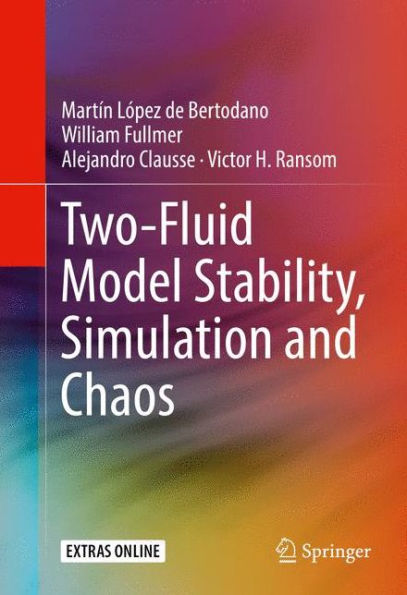Two-Fluid Model Stability, Simulation and Chaos
This book addresses the linear and nonlinear two-phase stability of the one-dimensional Two-Fluid Model (TFM) material waves and the numerical methods used to solve it. The TFM fluid dynamic stability is a problem that remains open since its inception more than forty years ago. The difficulty is formidable because it involves the combined challenges of two-phase topological structure and turbulence, both nonlinear phenomena. The one dimensional approach permits the separation of the former from the latter.
The authors first analyze the kinematic and Kelvin-Helmholtz instabilities with the simplified one-dimensional Fixed-Flux Model (FFM). They then analyze the density wave instability with the well-known Drift-Flux Model. They demonstrate that the Fixed-Flux and Drift-Flux assumptions are two complementary TFM simplifications that address two-phase local and global linear instabilities separately. Furthermore, they demonstrate with a well-posed FFM and a DFM two cases ofnonlinear two-phase behavior that are chaotic and Lyapunov stable.
On the practical side, they also assess the regularization of an ill-posed one-dimensional TFM industrial code. Furthermore, the one-dimensional stability analyses are applied to obtain well-posed CFD TFMs that are either stable (RANS) or Lyapunov stable (URANS), with the focus on numerical convergence.
"1124400802"
The authors first analyze the kinematic and Kelvin-Helmholtz instabilities with the simplified one-dimensional Fixed-Flux Model (FFM). They then analyze the density wave instability with the well-known Drift-Flux Model. They demonstrate that the Fixed-Flux and Drift-Flux assumptions are two complementary TFM simplifications that address two-phase local and global linear instabilities separately. Furthermore, they demonstrate with a well-posed FFM and a DFM two cases ofnonlinear two-phase behavior that are chaotic and Lyapunov stable.
On the practical side, they also assess the regularization of an ill-posed one-dimensional TFM industrial code. Furthermore, the one-dimensional stability analyses are applied to obtain well-posed CFD TFMs that are either stable (RANS) or Lyapunov stable (URANS), with the focus on numerical convergence.
Two-Fluid Model Stability, Simulation and Chaos
This book addresses the linear and nonlinear two-phase stability of the one-dimensional Two-Fluid Model (TFM) material waves and the numerical methods used to solve it. The TFM fluid dynamic stability is a problem that remains open since its inception more than forty years ago. The difficulty is formidable because it involves the combined challenges of two-phase topological structure and turbulence, both nonlinear phenomena. The one dimensional approach permits the separation of the former from the latter.
The authors first analyze the kinematic and Kelvin-Helmholtz instabilities with the simplified one-dimensional Fixed-Flux Model (FFM). They then analyze the density wave instability with the well-known Drift-Flux Model. They demonstrate that the Fixed-Flux and Drift-Flux assumptions are two complementary TFM simplifications that address two-phase local and global linear instabilities separately. Furthermore, they demonstrate with a well-posed FFM and a DFM two cases ofnonlinear two-phase behavior that are chaotic and Lyapunov stable.
On the practical side, they also assess the regularization of an ill-posed one-dimensional TFM industrial code. Furthermore, the one-dimensional stability analyses are applied to obtain well-posed CFD TFMs that are either stable (RANS) or Lyapunov stable (URANS), with the focus on numerical convergence.
The authors first analyze the kinematic and Kelvin-Helmholtz instabilities with the simplified one-dimensional Fixed-Flux Model (FFM). They then analyze the density wave instability with the well-known Drift-Flux Model. They demonstrate that the Fixed-Flux and Drift-Flux assumptions are two complementary TFM simplifications that address two-phase local and global linear instabilities separately. Furthermore, they demonstrate with a well-posed FFM and a DFM two cases ofnonlinear two-phase behavior that are chaotic and Lyapunov stable.
On the practical side, they also assess the regularization of an ill-posed one-dimensional TFM industrial code. Furthermore, the one-dimensional stability analyses are applied to obtain well-posed CFD TFMs that are either stable (RANS) or Lyapunov stable (URANS), with the focus on numerical convergence.
179.99
In Stock
5
1

Two-Fluid Model Stability, Simulation and Chaos
358
Two-Fluid Model Stability, Simulation and Chaos
358Hardcover(1st ed. 2017)
$179.99
179.99
In Stock

Product Details
| ISBN-13: | 9783319449678 |
|---|---|
| Publisher: | Springer International Publishing |
| Publication date: | 11/11/2016 |
| Edition description: | 1st ed. 2017 |
| Pages: | 358 |
| Product dimensions: | 6.10(w) x 9.25(h) x (d) |
About the Author
From the B&N Reads Blog
